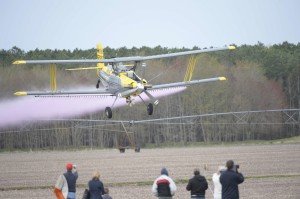Agricultural Aviators: Flying In For Safety
Normally, agricultural aviators don’t have much of an audience when they’re out spraying crops, but this past April 15 was an exception. There were more than 70 guests watching 10 planes and one helicopter, from sunup until just about sundown at Chorman Airport in Greenwood, DE. The occasion was a Professional Application Analysis Clinic for Chorman Spraying, LLC.
Known as Operation S.A.F.E. Fly-Ins, these events are performed all over the country to help ag aviation pilots or crop dusters self-regulate the safety and performance of their airplanes. S.A.F.E. stands for Self-regulating Application and Flight Efficiency. The National Agricultural Aviation Association (NAAA) created the S.A.F.E. program in 1981 in an effort to better control spray drift through professional application analysis. Pilots are urged to participate annually, and fly-ins are not limited to NAAA members.
Jeff Chorman was the highest bidder on an Operation S.A.F.E. fly-in at the NAAA annual meeting live auction in December 2012. Certified S.A.F.E. analysts John Garr of adjuvant manufacturer GarrCo Products, Inc. and Dr. Dennis Gardisser of WRK of Arkansas LLC, an application technology and aviation insurance company, have been conducting fly-ins for about 30 years combined. They donated their expertise, traveling with equipment in tow to Chorman Airport to check out 10 planes and one helicopter that serve the Delmarva Peninsula.
“We can all go to the meetings in the winter and sit through these lectures about pattern testing and nozzle placement, but unless you actually fly your airplane over the string and have a trained professional evaluate your spray pattern and make recommendations, you really don’t know exactly what’s coming out of your airplane, and how,” explained Chorman.
Pink dye is added to the spray tank to make the spray easy to see. Garr and Gardisser observed and performed computer tests on spray patterns and deposition. After measurement and analysis, they made adjustments and certified the aircraft. They were evaluating three key aspects of the spray:
1. Uniformity of the swath.
2. Effective swath width.
3. Droplet size.
Appreciating Customers
Chorman capitalized on Garr and Gardisser’s visit to host a customer appreciation event, bringing in about 70 customers, chemical salespeople and vegetable processors, as well as competitors, to observe the spray evaluation, talk to the experts and hear a presentation during lunch.
Gardisser commented that Chorman’s decision to bring in his customers, colleagues and competitors was a thoughtful way to connect. “The guests came before and stayed after the luncheon to observe,” he said. “They listened to consultations and asked a lot of technical questions about additives and surfactants.
“There is a misconception that higher volume is better, so we shared recent research that demonstrates that droplet spectrum is better than total volume,” continued Gardisser. “It’s much more efficient to use three to five gallons when some operators and farmers are using up to 10 gallons per acre.”
“We had a lot of conversations about tank mixes, and the right products and combinations of adjuvants to insure a homogenous mix and proper deposition,” Garr added. “And nozzle placement is always an important and easily corrected performance component.”
“We haven’t had the opportunity to pattern-test our airplanes, because there hasn’t been a fly-in clinic in this part of the country since the mid-1980s,” Chorman explained. “We’ve upgraded our fleet, and wanted to see exactly where we stood on swath, droplet size and so forth. I invited our competitors so we could all learn.”
“This is a very important program for our industry,” explained Andrew Moore, executive director of NAAA, who made the trip from the association’s office inside the Washington, DC, beltway to observe the event. “Between the pilots, operators, ground crew and all the cogs involved in the aerial application process, how these aircraft operate so quickly, effectively and efficiently is amazing. It’s a beautifully choreographed process. The farmers, the chemical companies and canneries, etc., seemed very impressed at the length industry goes to, to do what they do.”
In 2011, the aerial application industry included 1,350 operators with 2,835 aircraft, or 2.1 aircraft per operation.
“It was a great day,” Moore added. “This industry is very fortunate to have professionals such as Dennis Gardisser and John Garr that donate so much of their time, effort and resources to calibrating ag aircraft nationwide. Also for operators like the Chormans, who put their equipment through the calibration process. It is what makes Operation S.A.F.E. a premiere program, and the farmers reap the dividends.”
“We are the only operator on the Delmarva operating turbines up until this year, and we wanted to dispel the myth that a slower airplane does a better job than a turbine,” Chorman said. “That’s why we invited the chemical salesman and the vegetable processors to hear and see what Dennis and John had to say. I think it was very effective. Several people commented they didn’t know a heavier, faster airplane has better penetration than a lighter, slower one; or that by running less water but making the right droplet size is just as effective as running a higher gallon-per-acre.”
The added benefit is that Operation S.A.F.E. certified operators have maximized their performance, which gives them and their customers — especially Chorman customers, who saw this in action — peace of mind.
“I didn’t fully understand what the Operation S.A.F.E. program was all about until we were all done, and I had time to debrief with Dennis and John,” Chorman said. “Their expertise is excellent.”







